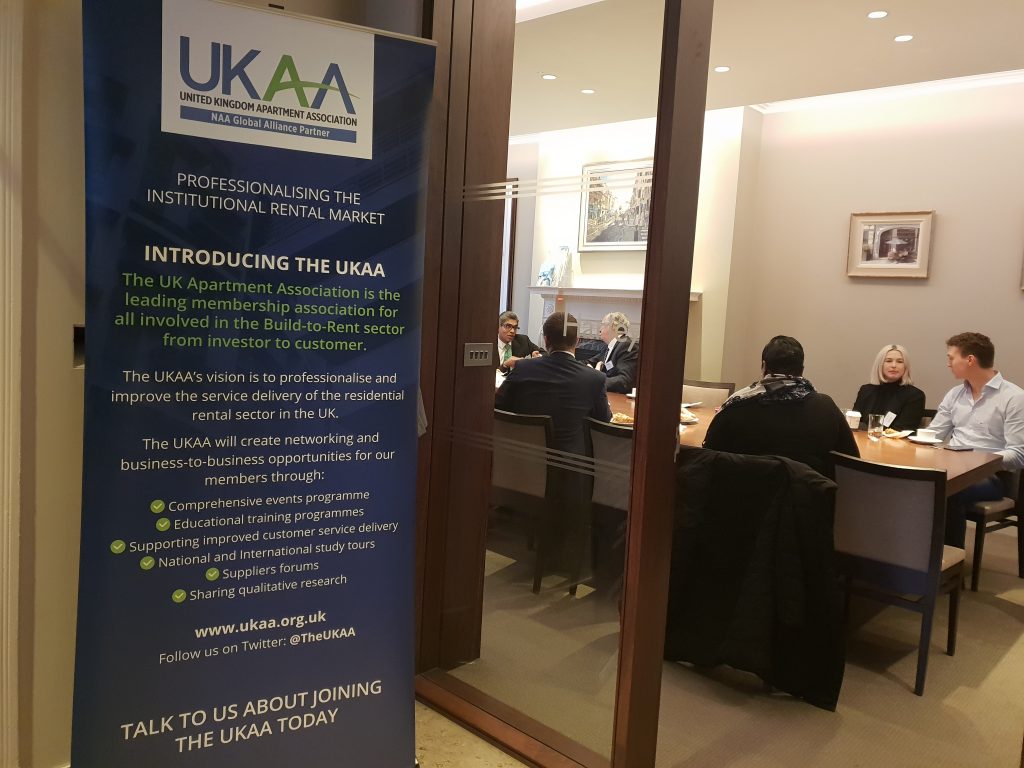
UKAA Roundtable: To Furnish, Or Not To Furnish? Delivered by Roomservice by CORT
Now that UK operators are increasingly comfortable with their amenity and facility proposition, as well as their customer service element, the build-to-rent market in the UK is facing a new and interesting chapter in terms of meeting tenant demand when it comes to providing properties as furnished or unfurnished.
As the leading provider of furniture rental services in the UK and the USA, Roomservice by CORT wanted to explore the challenges this question poses by chairing a UKAA Roundtable on the subject.
One thing is clear; the question is not as easy as the title might suggest, and with a number of experiences and approaches around the table, it was interesting to find out where the challenges are and how we can unite as an industry to develop a solution that works for the institutional landlords and the tenants – and of course, the bottom line.
It was helpful to have David Woodward of GAA give a US multi-family perspective, where the apartments are predominantly unfurnished, with a package provider working with the property company to offer the option to rent or purchase furniture direct to residents. However, in the UK, it’s increasingly obvious that although there is certainty of tenure, the market is still very fragmented.
Encouragingly, David Woodward is of the view that the build-to-rent market is one of the strongest and most appealing property asset classes, with consistent demand and high reward for relatively low risk. He also predicted that in time, as the market develops, unfurnished units will become the norm, particularly when you consider that a large proportion of tenants are part of generation ‘rent’ and players in the ‘on-demand’ economy.
With a demand for three year tenancies, and in some cases, five years, residents are now showing a greater commitment to renting long term, so can furnishing services or options add value for landlords and encourage or allow tenants to rent for longer? And should there be a premium on properties that are furnished?
There has never been a ‘premium’ concept for rent of furnished units in the UK before. With the offering of high quality, new build apartments, with customer service, community and amenities at the heart, tenants are already getting good value for money.
The US market has already proven that there is very little money to be made in charging more for furnished units, when you consider the cost and time of keeping inventory, moving, storing and replacing furniture, when you have churn of 100 to 150 units every year, it can be a logistical nightmare, and create significant cost.
Property location and the local market requirements also seem to have a huge influence on determining whether properties are offered furnished or unfurnished, with different age groups and demographics having different needs.
Jason Hardman for CBRE added that he is seeing a shift in the market for the landlords and investors in terms of the furniture question no longer being left as a last minute thought, although the market is still a bit ‘suck it and see’ up and down the country, and there is no current evidence to suggest that furniture is an incentive, or can command a premium.
Jason also noted that furniture can vary between being on and off the balance sheet and it’s not clear what’s best in terms of valuing assets.
Building design can also influence how furniture is offered – if these are purpose-built developments, then surely they can be designed and built with service lifts and access and appropriate corridor planning, to allow for a tenant or furniture provider to seamlessly deliver and replace items.
The personal aesthetic is also important, with Woods Bagot reminding us that some of today’s tenants are very focussed on trends and fashion and are living very transient lifestyles, as well as being used to ‘subscription-living’, everything from music on Spotify to car share clubs. Why shouldn’t they be able to curate certain pieces they want and that are ‘on trend’? There is an element of a tenant needing something now, but that may not fit their needs, trends or lifestyle in a year or two, so customisation and flexibility is key to meeting demand.
Initial cost and expected lifecycles of furniture was also raised with one operator saying that they are already going through a cycle of having to replace some furniture in their initial properties.
This raised a further discussion around initial furnishing costs, and whether there are any strategies in place covering the initial cost and the future replacement costs. One view expressed was that for some funders, as they plan to exit in 3 years or so from build, they would anticipate the new owner/ operator cover these replacement /upgrade costs.
The discussions were still continuing when the allocated time was reached, and left lots of other aspects around the topic of furnishing to be explored further, including the quality and durability of furniture offered; soft-furnishings and accessory packs; storage and removal costs; recycling and disposal; sustainability and wellbeing; dealing with void periods, and accounting for furniture costs.
With so many topics left to be explored, Roomservice by CORT and the UKAA will be holding further roundtables on these specific topics early in the New Year, both in London and Manchester.
Ultimately, it keeps coming back to the heart of the corporate landlord model of real customer service – we need to be flexible enough to be able to give the tenants what they want, when they want it.

